|
|
 |
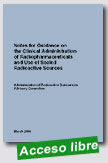 |
Notes for Guidance on the Clinical Administration of Radiopharmaceuticals and Use of Sealed Radioactive Sources
Administration of Radioactive Substances Advisory Committee (UK), March 2006, 80 p.
These Notes provide
general guidance for use by medical and dental practitioners concerned with the administration of radiopharmaceuticals to and the use of sealed radioactive sources with human beings. A description of the Regulations and Order specific to these practices is given in his section.
|
|
A summary of additional associated statutory requirements in relation to the medical use of ionizing radiations (including radioactive substances) is given in Appendix V. Particular attention is drawn to the Ionising Radiation (Medical Exposure) Regulations 2000.
extraído
de:
http://www.arsac.org.uk/notes_for_guidence/docs/arsac_nfg.pdf
|
 |
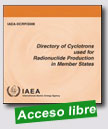 |
Directory of Cyclotrons Used for Radionuclide Production in Member States 2006 Update
IAEA, 17 November 2006, CD-ROM, 538 p.
Radioisotope production by accelerators has been steadily increasing in the last 10 years. Positron emission tomography (PET) imaging, which is the diagnostic method of choice, relies heavily on the production of short-lived isotopes namely F-18, C-11, N-13 and O-15. There are 262 cyclotrons recorded operating in 39 Member States of the
|
|
IAEA. This is an increase of 7% over the 246 reported in the 2002 cyclotron directory. This can be compared to the 350 or so cyclotrons believed to be presently operating in the world, which are involved in some aspects of radionuclide production. The increase in the number of cyclotrons has been to a certain extent in developed countries. However, there is a greater growth in the number of cyclotrons in developing countries. The number of institutions which distribute some radiopharmaceuticals and 18F-FDG, in particular, is significant and growing. 75% of the cyclotrons reported in this directory are being used to produce FDG either for internal use or for distribution.
extraído
de:
http://www-pub.iaea.org/MTCD/publications/PubDetails.asp?pubId=7608
|
 |
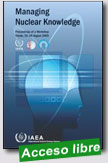 |
Managing Nuclear Knowledge
Proceedings of a workshop held in Trieste, Italy, 22-26 August 2005
IAEA, 2006, 289 p.
The nuclear power and technology sector, comprising the industry, governments and academia, is a knowledge based endeavour similar to other highly technological industries. Recent trends, such as an ageing workforce and declining student enrolment, with the consequent risk of losing accumulated nuclear knowledge and experience, have drawn attention to the need for better management of nuclear
|
|
knowledge. These Proceedings are based on a workshop on managing nuclear knowledge which was jointly organized by the IAEA, the Abdus Salam International Centre for Theoretical Physics and the World Nuclear University. The aim was to increase the awareness of Member States with respect to the challenge of nuclear knowledge management, to share the best practices and to provide a forum for the exchange of information among participating nuclear professionals.
extraído de:
http://www-pub.iaea.org/MTCD/publications/PubDetails.asp?pubId=7521 |
 |
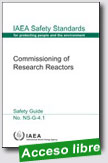
|
Commissioning of Research Reactors Safety Guide
Safety Standards Series No. NS-G-4.1
STI/PUB/1268, 65 pp.; 0 figures; 2006
ISBN 92-0-109606-2, English. 28.00 Euro. Date of Issue: 7 December 2006.
Full Text, (File Size: 393 KB )
The Safety Guide on the Commissioning of Research Reactors provides recommendations for the commissioning research reactors on the basis of the international best practices. The guidance and recommendations of this Safety Guide are applicable to most types of research reactor and
|
|
fulfil the general requirements on research reactor safety presented in IAEA Safety Standards Series No. NS-R-4, Safety of Research Reactors, as well as those in IAEA Safety Standards Series No. 35-G-1. Commissioning is one of the major steps in the life cycle of a research reactor, and appropriate guidance for conducting the process is essential. Emphases in this Safety Guide are on the commissioning of a new research reactor, but guidance is also provided on the commissioning of new experiments and of reactor modifications.
extraído
de:
http://www-pub.iaea.org/MTCD/publications/PubDetails.asp?pubId=7575
 |
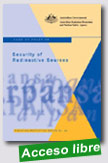 |
Code of Practice for the Security of Radioactive Sources
Australian Radiation Protection and Nuclear Safety Agency, 2007, 44 p.
This Code of Practice gives effect to the agreement of the Radiation Health Committee that a set of security outcomes be developed and considered for inclusion in the National Directory for Radiation Protection.
The purpose of this Code of Practice is to set out the
|
|
security requirements to be implemented by persons dealing with a radioactive source in order to decrease the likelihood of the unauthorised access to or acquisition of the radioactive source by persons with malicious intent. It is intended that this Code be given the force of law by each State and Territory and the Commonwealth, and administered by the regulatory authority in each jurisdiction as part of the regulatory framework governing the use of radiation.
The publication was developed by a working group of the Radiation Health Committee, as part of the Committee's role in formulating draft national policies, codes and standards for consideration by the Commonwealth, States and the Territories.
extraído
de:
http://www.arpansa.gov.au/pubs/rps/rps11.pdf
|
 |
|
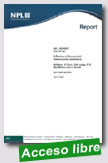
|
A review of commercial radionuclide calibrators
National Measurement Laboratory (UK), July 2005, 33 p.
Radionuclide Calibrators are used in nuclear medicine departments to assay the radioactive content of radiopharmaceuticals prior to administration to the patient. The aim of the measurement is to ensure that the patient receives the lowest practicable radiation dose compatible with obtaining a good quality image for diagnostic purposes or with delivering the required dose to the tumour in therapeutic use.
|
|
It is a condition of the license to use radiopharmaceuticals (ARSAC certificate) that are activity administered is within 10% of the prescribed activity. This implies that the Radionuclide Calibrators should have an accuracy better than this - perhaps around 5%. This report summarises the results from tests of commercial Radionuclide Calibrators to verify the accuracy of such measurements if the instrument is used 'as is' from the manufacturer. Nine commercial Radionuclide Calibrators were obtained from the manufacturers for testing. Each chamber was tested using samples of typical radionuclides used in nuclear medicine (18F, 00Cr, 67Ga, 99mTc, 111In, 123I, 125I, 131I, 201TI). Each nuclide was dispensed into common formats (2ml BS ampoule, 10R Schott vial, 2 ml BD syringe, 5 ml BD syringe and P6 vial).
The results show that some instruments do meet the 5% specification on accuracy for a range of radionuclides and sample formats. However, some instruments give readings that are significantly in error (up to 90% wrong), others show systematic discrepancies for all the radionuclides tested. The conclusion is that experimental verification of the accuracy of commercial Radionuclide Calibrators is essential when used in the clinical setting.
extraído de:
http://publications.npl.co.uk/npl_web/pdf/dql_rn3.pdf
|
 |
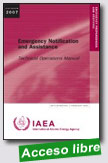 |
Emergency Notification and Assistance Technical Operations Manual
IAEA, 2007, 58 p.
Convention on Assistance in the Case of a Nuclear Accident or Radiological Emergency (the ‘Assistance Convention’) are the prime legal instruments that establish an international framework to facilitate the exchange of information and the prompt provision of assistance in the event of a nuclear or radiological emergency, with the aim of minimizing the consequences. The International Atomic Energy Agency has
|
|
specific functions assigned to it under these Conventions, to which, in addition to a large number of States, the World Health Organization (WHO), the World Meteorological Organization (WMO) and the Food and Agriculture Organization of the United Nations (FAO) are full parties. The arrangements provided between the IAEA, States that are IAEA Member States and/or Parties to one or both Conventions, all other relevant international intergovernmental organizations, and other States for facilitating the implementation of these Conventions — specifically concerning those articles that are operational in nature — are documented in the Emergency Notification and Assistance Technical Operations Manual (ENATOM).
extraído de:
http://www-pub.iaea.org/MTCD/publications/PubDetails.asp?pubId=7686
|
 |
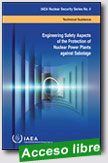 |
Engineering Safety Aspects of the Protection of Nuclear Power Plants against Sabotage
IAEA, 2007, 58 p.
The product of extensive dialogue among safety and security specialists, this report provides guidelines for evaluating the engineering safety aspects of the protection of nuclear power plants against sabotage, including standoff attacks. The guidance takes into account the existing robustness of structures, systems and components, and emphasizes those aspects of sabotage protection that work |
|
synergistically with the protection against extreme external occurrences of accidental origin, such as earthquakes, tornadoes and human induced events. The report introduces a defence in depth approach to sabotage protection, with layers comprising safety and security related systems and activities, and promotes self-assessment by the licensee in cooperation with the required interfaces with the competent authorities.
extraído de:
http://www-pub.iaea.org/MTCD/publications/PubDetails.asp?pubId=7574
|
 |
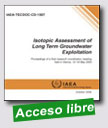 |
Isotopic Assessment of Long Term Groundwater Exploitation
IAEA, 2006, CD-ROM
There is a worldwide need to better understand and predict hydrodynamic changes induced by exploitation of groundwater resources. The overall objective of the CRP was to make an assessment of the potential use of long-term |
|
isotope responses of hydrological systems, particularly groundwater aquifers in arid and semi-arid regions. The results demonstrate that environmental isotopic and geochemical tracers can be used to evaluate the hydrological consequences of long-term utilization of water resources. This study provides a synthesis of time-series of hydrochemical, isotope and geohydrological data which will be used for quantitative assessment of the long-term dynamic response of the groundwater system. Specific outcomes include the establishment of methodologies for monitoring and predicting changes in water quality and quantity that will lead to improved water resources management. The results show that isotopic tools should be integrated into hydrological evaluation, model predictions and management plans.
extraído de:
http://www-pub.iaea.org/MTCD/publications/PubDetails.asp?pubId=7454
|
|
|
|
